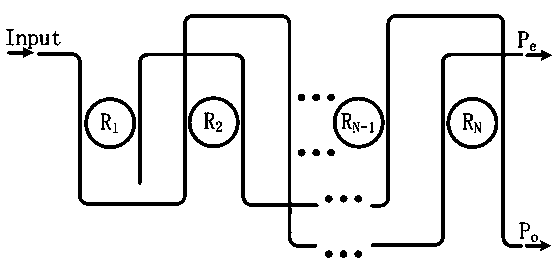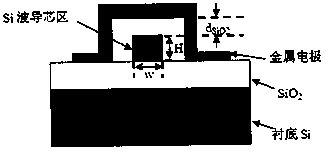N-bit binary-system electro-optic odd-even checker
A parity check, binary technology, applied in the field of N-bit binary electro-optical parity checker, can solve the problem of small size, achieve the effect of small size, fast check speed and low power consumption
- Summary
- Abstract
- Description
- Claims
- Application Information
AI Technical Summary
Problems solved by technology
Method used
Image
Examples
Embodiment Construction
[0021] The present invention will be described in further detail below in conjunction with the accompanying drawings and specific embodiments.
[0022] The N-bit binary electro-optical parity checker of the present invention is composed of N ring waveguides and two curved waveguides, referring to the attached figure 1 , whose basic structure is an MRR-based optical switch, consisting of only one structure of MRR, made of silicon-based nanowire waveguides, N microring resonator MRRs made of semiconductor materials on insulators and two curved Nanowire waveguide implementation, each microring resonator MRR is coupled with two nanowire waveguides, see attached figure 2 . There is a gap or insulation between two adjacent microring resonators MRR that can prevent thermal crosstalk between them.
[0023] The MRR structure of the thermal modulation mechanism or electric modulation mechanism of the present invention is shown in image 3 .
[0024] The input of the device of the ...
PUM
 Login to View More
Login to View More Abstract
Description
Claims
Application Information
 Login to View More
Login to View More - R&D
- Intellectual Property
- Life Sciences
- Materials
- Tech Scout
- Unparalleled Data Quality
- Higher Quality Content
- 60% Fewer Hallucinations
Browse by: Latest US Patents, China's latest patents, Technical Efficacy Thesaurus, Application Domain, Technology Topic, Popular Technical Reports.
© 2025 PatSnap. All rights reserved.Legal|Privacy policy|Modern Slavery Act Transparency Statement|Sitemap|About US| Contact US: help@patsnap.com



